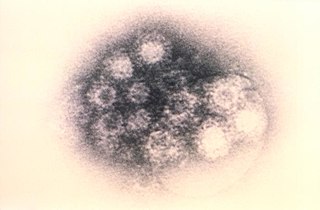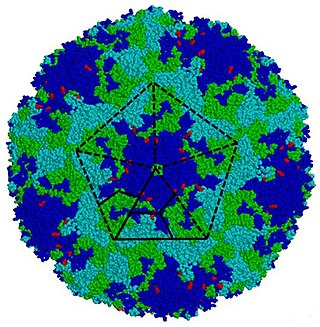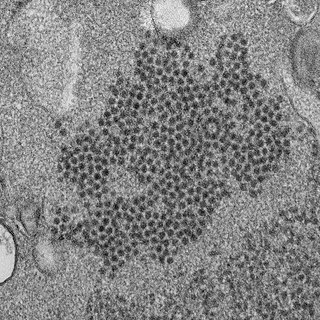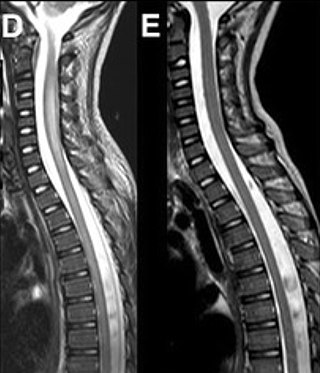| 2018 Malaysia HFMD outbreak | |
|---|---|
| Disease | Hand, foot, and mouth disease |
| Virus strain | Coxsackievirus A16 [1] and Enterovirus 71 [2] |
| Index case | January 2018 |
| Confirmed cases | more than 50,000 [1] |
Deaths | 2 |
Beginning in January 2018, an outbreak of hand, foot, and mouth disease (HFMD) occurred among children nationwide across Malaysia. Nearly 38,000 cases were recorded between January 1 and July 26, [3] and by August 14 the total number of cases had risen to 51,000. [1] Among the states and federal territories affected by the outbreak, Selangor recorded the highest cases with 11,349, Kuala Lumpur with 4,428 and Sarawak with 4,412 cases as reported in July 2018. [3] At least two children in Sarawak and Penang died from complications caused by the virus. [4] [5]
HFMD transmission outbreak in Malaysia was first reported in the state of Sarawak in 1997 where between 28 and 31 children died as a result of infection by the Enterovirus 71 (EV-A71) virus. [6] [7] Since then, recurrent cyclical epidemics of HFMD have occurred in the country every two to three years. [6] While the root cause behind the recurrence of the disease remains a mystery, another factor that has been identified as increasing the spread of the disease among children is travel to neighbouring countries with high infection rates. [7] Through autopsies performed on deceased individuals, death has been attributed to several symptoms linked to the disease such as poor peripheral perfusion, tachycardia and cardiac failures. [7] These individuals had also developed symptoms earlier on such as shock, pallor, cold extremities, delayed capillary refill and weak peripheral pulses. [7] In 1998, the Ministry of Health acknowledged that the disease was endemic in the country with periodic outbreaks among young children. Since the first outbreak, the Ministry of Health has periodically ordered the closure of affected kindergartens and schools which are likely to be the source area of the disease. A further outbreak of 1,178 cases, mostly in kindergartens nurseries, was reported in the state of Johor in 2000 following an outbreak in neighbouring Singapore a month before. [7]
In July 2018, Malaysian Health Ministry Disease Control Division director Chong Chee Keong said toys were among the cause of immediate spread of the virus to other children. [8] The Health Ministry further reported that HFMD disease cases had exceeded warning levels. [9] To prevent spread, the Ministry urged parents to act as "gate-keepers" in order to ensure children infected with the disease did not go to school and to seek immediate treatment if their children showed signs of infection. [10] The Education Ministry issued a letter to every school to monitor the health of their students. [11] The Health Ministry also considered the use of vaccines from other countries, though research on vaccines had to be carried out before they could be approved for local use. [12] As infection rates increased among children, the local health department of Penang ordered all supermarkets and shopping complexes in the state to disinfect trolleys, toys and benches on their premises. [13] Disinfection was also carried out in all villages, schools and preschools in a district in Sarawak. [14]

Coxsackie A virus (CAV) is a cytolytic Coxsackievirus of the Picornaviridae family, an enterovirus.

Hand, foot, and mouth disease (HFMD) is a common infection caused by a group of enteroviruses. It typically begins with a fever and feeling generally unwell. This is followed a day or two later by flat discolored spots or bumps that may blister, on the hands, feet and mouth and occasionally buttocks and groin. Signs and symptoms normally appear 3–6 days after exposure to the virus. The rash generally resolves on its own in about a week. Fingernail and toenail loss may occur a few weeks later, but they will regrow with time.

Coxsackieviruses are a few related enteroviruses that belong to the Picornaviridae family of nonenveloped, linear, positive-sense single-stranded RNA viruses, as well as its genus Enterovirus, which also includes poliovirus and echovirus. Enteroviruses are among the most common and important human pathogens, and ordinarily its members are transmitted by the fecal–oral route. Coxsackieviruses share many characteristics with poliovirus. With control of poliovirus infections in much of the world, more attention has been focused on understanding the nonpolio enteroviruses such as coxsackievirus.

Enterovirus is a genus of positive-sense single-stranded RNA viruses associated with several human and mammalian diseases. Enteroviruses are named by their transmission-route through the intestine.

Enterovirus 71 (EV71), also known as Enterovirus A71 (EV-A71), is a virus of the genus Enterovirus in the Picornaviridae family, notable for its role in causing epidemics of severe neurological disease and hand, foot, and mouth disease in children. It was first isolated and characterized from cases of neurological disease in California in 1969. Enterovirus 71 infrequently causes polio-like syndrome permanent paralysis.

Foot-and-mouth disease (FMD) or hoof-and-mouth disease (HMD) is an infectious and sometimes fatal viral disease that affects cloven-hoofed animals, including domestic and wild bovids. The virus causes a high fever lasting two to six days, followed by blisters inside the mouth and near the hoof that may rupture and cause lameness.

The 2009 flu outbreak in Malaysia was part of a larger flu pandemic involving a new type of influenza A virus subtype H1N1 virus. As of 11 August 2009, the country had over 2,253 cases, beginning with imported cases from affected countries, including the United States and Australia from 15 May 2009 onwards, and the first identified local transmission on 17 June 2009. From 12 August 2009, the Malaysian Health Ministry said that it had discontinued officially updating the total number of H1N1 cases within Malaysia in line with guidelines issued by the World Health Organization. As of 21 August 2009 the unofficial number of cases reported in the media is 5,876 so far. The first death related to the A(H1N1) virus was reported on 23 July 2009 and so far there have been 78 deaths reported. On 6 July 2009 Malaysia announced that it was shifting from containment to mitigation to tackle the spread of the virus. The federal government had declared a national health emergency in Malaysia because of the A(H1N1) outbreak and was considering imposing a health curfew similar to the week-long shutdown of non-essential services and industries in Mexico.

Ebola, also known as Ebola virus disease (EVD) and Ebola hemorrhagic fever (EHF), is a viral hemorrhagic fever in humans and other primates, caused by ebolaviruses. Symptoms typically start anywhere between two days and three weeks after infection. The first symptoms are usually fever, sore throat, muscle pain, and headaches. These are usually followed by vomiting, diarrhoea, rash and decreased liver and kidney function, at which point some people begin to bleed both internally and externally. It kills between 25% and 90% of those infected – about 50% on average. Death is often due to shock from fluid loss, and typically occurs between six and 16 days after the first symptoms appear. Early treatment of symptoms increases the survival rate considerably compared to late start. An Ebola vaccine was approved by the US FDA in December 2019.

Enterovirus D68 (EV-D68) is a member of the Picornaviridae family, an enterovirus. First isolated in California in 1962 and once considered rare, it has been on a worldwide upswing in the 21st century. It is suspected of causing a polio-like disorder called acute flaccid myelitis (AFM).

In August 2014, enterovirus D68 caused clusters of respiratory disease in the United States. Cases of EV-D68 have occurred in the U.S. for decades, having first been detected in California in 1962. According to the Division of Viral Diseases at the National Center for Immunization and Respiratory Diseases EV-D68 "is one of the most rarely reported serotypes, with only 26 reports throughout the 36-year study period ."

Acute flaccid myelitis (AFM) is a serious condition of the spinal cord. Symptoms include rapid onset of arm or leg weakness and decreased reflexes. Difficulty moving the eyes, speaking, or swallowing may also occur. Occasionally, numbness or pain may be present. Complications can include trouble breathing.

The Sarawak rabies outbreak is an ongoing rabies outbreak in the state of Sarawak in Malaysia. Until 6 December 2022, 49 confirmed rabies cases and 44 deaths have been reported.
The 2019 Kuala Koh measles outbreak was a measles outbreak that occurred among the Orang Asli sub-group of Batek people in Kuala Koh Village in the state of Kelantan, Malaysia, from May until July. Following the sudden deaths of several villagers, the disease became a mystery among the villagers and public for nearly a month until it was identified by the Malaysian Health Ministry in mid-June as measles.
The 1997 Sarawak HFMD outbreak is a hand, foot, and mouth disease (HFMD) outbreak from April until June caused by the Enterovirus 71 (EV-71) affecting 600 children in the state of Sarawak in Malaysia. Sarawak is the first state in Malaysia that reported HFMD outbreak. An estimated 28 to 31 of the infected children died as a result. The affected children are aged between five months to six years.

The 1998–1999 Malaysia Nipah virus outbreak was a Nipah virus outbreak occurring from September 1998 to May 1999 in the states of Perak, Negeri Sembilan and Selangor in Malaysia. A total of 265 cases of acute encephalitis with 105 deaths caused by the virus were reported in the three states throughout the outbreak. The Malaysian health authorities at first thought that Japanese encephalitis (JE) was the cause of the infection. This misunderstanding hampered the deployment of effective measures to prevent the spread, before the disease was identified by a local virologist from the Faculty of Medicine, University of Malaya as a newly discovered agent. It was named Nipah virus (NiV). The disease was as deadly as the Ebola virus disease (EVD), but attacked the brain system instead of the blood vessels. University of Malaya's Faculty of Medicine and the University of Malaya Medical Centre played a major role in serving as a major referral centre for the outbreak, treating majority of the Nipah patients and was instrumental in isolating the novel virus and researched on its features.

The COVID-19 pandemic in Malaysia was a part of the ongoing worldwide pandemic of coronavirus disease 2019 caused by severe acute respiratory syndrome coronavirus 2. As of 10 February 2023, with over 5 million confirmed COVID-19 cases, a high of approximately 323,000 active cases, nearly 40,000 deaths, and over 66 million tests, the country is currently ranked third in the number of COVID-19 cases in Southeast Asia behind Vietnam and Indonesia, and fourth in the number of COVID-19 deaths in Southeast Asia behind Indonesia, the Philippines, and Vietnam.
The COVID-19 pandemic was confirmed to have reached Sabah, Malaysia, in March 2020. As of 16 November 2022, there are 402,031 confirmed cases.
The following is a timeline of the COVID-19 pandemic in Malaysia during 2020.

The COVID-19 pandemic in Malaysia has had a significant impact on the Malaysian economy, leading to the devaluation of the Malaysian ringgit (MYR) and the decline in the country's gross domestic product. The pandemic also adversely affected several key sectors including entertainment, markets, retail, hospitality, and tourism. Besides shortages in goods and services, many businesses had to cope with social distancing and lockdown restrictions, which affected their operations and revenue. The pandemic also drew attention to workplace safety and the exploitation of migrant workers working in Malaysian industries.

In the waning months of 2022, the first northern hemisphere autumn with the nearly full relaxation of public health precautions related to the COVID-19 pandemic, hospitals in the United States and Canada began to see overwhelming numbers of pediatric care patients, primarily driven by a massive upswing in respiratory syncytial virus (RSV) cases, but also flu, rhinovirus, enterovirus, and SARS-CoV-2.
Over 50,000 cases of hand, foot and mouth disease (HFMD) stemming from the Coxsackie virus have been reported since the outbreak of the disease.
For the year 2018, up to 316 nurseries/kindergartens/pre-schools reported HFMD clusters at their premises, which is 52% of the total epidemic reported. HFMD virus surveillance also found an increase in enterovirus-71 (EV71) activity in the environment since March 2018.